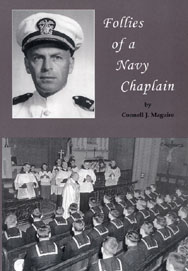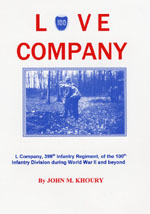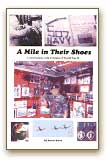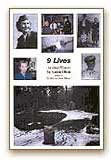Clyde Phelps is a veteran of the 90th Infantry Division.
©2004, 2009 Clyde Phelps
Prelude
I did not sleep well the night of June 5/6, 1944. Intermittently, I tossed and turned on my Army cot to the sound of seemingly thousands of airplane engines throbbing overhead. In the morning, groggy from lack of sleep, I, along with several thousand companions stationed as U.S. Army infantry replacements in a "tent city" in the heathered hills (moors) of northern Devonshire, England, were assembled and told that the long–expected invasion of Hitler's "Fortress Europe" had begun! Paratroop and glider troops had been dropped in the early hours of the day, and even as we listened, beach landings were taking place in a combined allied (U.S., British, Canadian, and some Free French) operation on the Cotentin Peninsula in the ancient French province of Normandy. We were also informed that we were now on official alert and should be prepared to move out at any time.
Thus began my involvement – the small part I was to play – in the great "D–Day" invasion which the Supreme Allied Commander, General Dwight D. Eisenhower, had described a short time before in a radio broadcast directed at "the people of western Europe" as the beginning of the crusade of their liberation from four years of German (Nazi) tyranny.
In many ways up to that point, my military experience was typical of several million other young American males at the time. Drafted a few months after high school graduation and my 18th birthday into the U.S. armed forces – in my case, the U.S. Army – for "the duration plus six months." However, unlike most, I had been assigned to a wartime training camp (Camp Fannin, Texas) for infantry basic training. The camp was one of a number designated as "IRTCs" – Infantry Replacement Training Centers. As the U.S. got more deeply involved in ground fighting (this was the autumn of 1943) in its two-front war, the selective service system was called on increasingly to supply infantry replacements for the growing casualties in that branch of the service.
After 17 weeks of intensive training – much of it like that experienced to this day in Marine Corps "boot camp" – and a short furlough, my orders directed me to the U.S. East Coast (Fort Meade, Md.), and then to a port of embarkation (Staten Island, New York Harbor). After boarding a troop transport at a pier in Staten Island, there was an 11-day trip (average speed about 10 mph) in a heavily guarded convoy across the North Atlantic to the British Isles – more precisely, to the Scottish port of Greenock, just below Glasgow. Presently, there followed an all-day troop train ride to Southwest England and the aforementioned tent city in Devon (Haddon Hill). There were then about eight weeks of training in that isolated camp – no passes, no leaves – before the alert on D-Day.
On the morning of June 8th we packed our duffel bags and with our zeroed-in new M-1 rifles (we were all riflemen) left the camp and boarded trucks for the start of our journey. The truck ride was short, not more than 10 miles, to a rail line. There we boarded first class British passenger railway carriages. Then, it was a fairly long ride of some hours to the battered southern English port city of Plymouth. Much of the ride was along the southwestern English coast, and it was interesting to observe all the coastal defenses the British had erected when threatened with invasion in 1940-41.
At Plymouth (located right by its inner harbor) we were processed through a center used less than a week before by some of the invasion forces. We were issued impregnated fatigues to wear over our olive drab uniforms, gas capes (there was fear that Hitler, in desperation, might order use of poisoned gas against invasion forces), plus bandoliers of live ammunition and canned heat (for cooking rations). We also got our last hot meals and were issued "K" and "D" rations for subsequent use. Those condensed rations were all the official rations we were issued during the time I was in Normandy.
We spent about three days in the camp in Plymouth, sealed off from any contact with the civilian world. The only news we got were daily editions of the Army news paper Stars and Stripes. From reading it, I got the impression that we were making rapid progress in consolidating the beachheads in Normandy.
A note here: Unlike troops in later U.S. wars, we were literally searched to make sure we carried no hidden diaries or cameras. Our mail had been censored from the time we arrived in the British Isles.
On June 11th, we were ferried in U.S. Navy LCVPs (landing craft) out to a British transport anchored in the harbor. I suppose it could be described as an attack transport. It had a Royal Navy crew for its guns and handling of landing craft, and Merchant Navy (our Merchant Marine) civilians to run the ship. Instead of lifeboats it carried British landing craft on the davits. These landing craft were relatively small and lightweight, made mostly of plywood, and could carry about 25 men each. We went aboard the same way we left – via a cargo net over the side.
June 12
As we came on deck on the morning after leaving Plymouth, we found a sparkling bright day, and that we were anchored about a quarter of a mile off of (we were told) "Utah Beach." The following impressions are still with me of that morning: The beach and area around us were swarming with activity. It couldn't have changed much from D–Day, only six days earlier. There were a number of cargo ships to be seen discharging cargo (ammo and rations) over the side in cargo nets into waiting amphibious trucks, called DUKWs, which took their cargo ashore where it was transferred to regular trucks. About 300 yards away on one side of our transport, the old battleship Nevada (sunk at Pearl Harbor and raised) was serving as a floating gun platform, periodically firing its 15-inch guns on targets inland. It occurred to me that. the bridgehead beyond the beaches was not as deep as the Stars and Stripes had suggested! Utah Beach itself appeared as a strip of yellow-white sand with a low sand dune barrier. Beyond was a low-lying. countryside with no dwellings visible. Unlike nearby Omaha Beach, there were no coastal bluffs. Above some of the ships and part of the beach waved barrage balloons.
During the morning of the 12th we were issued two interesting items: l) An English-French booklet containing a lot of basic phrases that would supposedly come in handy in our contact with French civilians. It contained both actual and phonetic spelling of words. However, for someone like me with no formal French instruction, it wasn't really very helpful. Correct and understandable French pronunciation is very difficult for English speakers. But it was certainly better than nothing. 2) We were also issued 200 Francs each of invasion currency in denominations of one, five and twenty Francs. Each Franc was officially worth two cents. We spent much of the rest of the day lounging around on deck, talking and with some crap shooting and poker playing with the new currency. For a while also we were frightened by a typical "latrine rumor" which swept the ship that we were going to be part of a new landing somewhere. I guess the live ammo we had been issued fueled it. Of course, as we were only replacements and not yet even part of an organized outfit, logic finally prevailed, and we calmed down somewhat.
June 13
The next day (June 13th) turned out to be a hectic one. In the morning we were ordered to leave our duffel bags behind, but still burdened with packs, life jackets, gas masks and rifles, we descended cargo nets over the transport's sides into the landing craft which had been lowered into the water. A dangerous moment occurred as my group got into its landing craft. Because of the heavy swell, an unhooked davit swung in an arc from one end of the craft to the other. This had the potential of injuring and even killing a number of us. Most of us "hit the deck," and fortunately it missed us. After several swings, it was pulled up and away from us by deck crewmen.
Our landing craft was powered by an engine in the stern, and steered by a one-man crew, a coxswain of the Royal Navy. My mood could be described as being curious about the drama taking place around me, but not really being eager to get directly involved. Therefore, I stood by the coxswain in the stern.
About 50 yards from the beach, we suddenly stopped. Thinking this was it, a number of my companions jumped into the water which was about waist- to chest-high, and began wading ashore. The coxswain told me it was just a sandbar and not to jump in. He easily backed the craft off the sandbar and ran its prow up on the beach passing the men struggling in the water in the process. I stepped ashore without so much as getting my boots wet!
Now I could take in part of the beach activity I had only seen previously from a distance. Both men and amphibious trucks were being directed by members of a specialized Army engineering unit with large and colorful identifying unit patches on their sleeves. Some of them had been. the first ashore to mark the beach and guide the first waves in. Their only order to us was clear the beach and move inland.
We walked through one of several breaks bulldozed through the barrier dune, which were, in effect, the roads off the beach. I noticed several wrecked German pillboxes which had been built into the barrier dune. I also noticed a small, miniature tank lying, on its side. I had previously read about this device, although I can't recall what it was called. It was radio-controlled and contained about 1,000 pounds of TNT. Fortunately, in this case it hadn't exploded.
Just beyond the barrier dune was an enemy mine field about 50 to 100 feet wide. It was marked with death-head "Achtung Meinen" signs. Of course, a wide path had been marked and cleared through it, probably by Army combat engineers. This connected up with a paved road of the local French system, and we were told to just keep marching inland with more specific instructions promised for later.
It was another bright and sunny day, and once off the beach, very peaceful and quiet. We marched casually at "route step" with intervals of ten feet or so between men on each side of the road so motorized traffic could move in between. Sharing the road with us were members of the veteran 9th Division who were also coming ashore.
All we knew was that we were replacements for some infantry division; which one was still classified information to us. A rumor spread that it was the 9-something. The 9th Division guys told us maybe it was them, and that we would be lucky if it was because they were a good outfit (which they were). Of course, they hadn't had any casualties yet in Normandy, and therefore they didn't need any replacement yet so it wasn't them.
A few hundred yards in from the beach, I met my first French civilian. He was a boy of about fifteen or sixteen pushing his bicycle. I greeted him with about the only French words I knew at the time – "Bon jour." His friendly response was interesting – "Sprechen Zie Deutsch?" He obviously knew no English but had picked up a fair amount of German from his occupiers!
We seemed to be marching pretty much in a western direction. After covering a few miles we entered our first French village. For a long time I thought it was the famous St. Mere Eglise, but realize now it was probably St. Marie du Mont. It appeared undamaged to me but few civilians were about. One lasting impression of this village – at its center stood a roadside public pump similar to those that were still common on U.S. farms in my childhood. We filled our canteens but were careful to add the prescribed number of water purification tablets.
So far, we hadn't heard a shot fired in anger or otherwise. However, a mile or so beyond the village, we had a reminder of the nearby war. As we passed a crossroads, we heard several shots that obviously did not come from U.S. weapons. A nearby MP told us that there had been instances of local French women sniping at our forces. At the time, I had been so indoctrinated about all French hating all Germans that I found this hard to believe. But such instances were verified and are noted in the official U.S. Army history of the Normandy campaign. After all, the Germans had been in occupation of this part of France for four years. It was a rich farming area and could feed both occupiers and occupied. Also, most Frenchmen of military age had been and still were POWs in Germany.
Our propaganda had also made most of us believe that we would literally be met at the beach by French Forces of the Interior (FFI) underground fighters. Of course, for good reasons, they weren't there, but that didn't mean they didn't exist. I never encountered any of them out in the open in Normandy, but our forces met and worked with a lot of them later on after the breakout, especially in Brittany and beyond.
By late afternoon we had probably covered eight to ten miles. The word was passed down to turn off the road and into nearby fields for the night. As dusk fell (about ten p.m.; we were on double British Summer Time, two hours ahead of regular), trucks drove into our field. They contained our duffel bags from the transport. We were given 15 or 20 minutes to go through the contents of our bags. I removed a few personal effects from mine. The bags were then returned to the trucks which drove off. (I never saw my duffel bag again, although shortly after my Army discharge after the war, all of the personal effects I had left in it were returned).
In the gathering darkness I bedded down into a fortunately dry ditch in front of a hedgerow and was soon asleep. It had been a long day! A few hours later I awoke with a start to the sights and sounds of a German bombing raid on Utah Beach. Perhaps it would be more accurate to say that it was an attempted bombing raid as I heard no bombs actually explode. A German recon plane (probably a light bomber) was flying lazily overhead with much antiaircraft fire from the beach area trying to bring it down – without success. It wound up dropping several parachute flares and then droned away into the night. The engines of the German plane had a different sound than ours. They sort of sounded like a couple of washers were loose in them. Why, I never really found out.
June 14
The next morning (June 14th) we awoke to the sound of trucks again turning into the field. These turned out to be from the 90th Infantry Division (at last we found out), come to carry us to our assigned regiments within the division. After a short ride, we found ourselves at the Headquarters of the 358th Infantry Regiment. All around us were men wearing an unfamiliar (to us) shoulder patch emblazoned with the letter T crossing the letter 0 in red. The TO stood for Texas/Oklahoma as the 90th was originally made up of Army Reserve units from those states. The division later acquired the nickname "Tough 'Ombres."
While we waited, a lanky sergeant first class from Oklahoma gave us an impromptu lecture about what the division had learned about German battle tactics in the hedgerow fighting they had been engaged in for less than a week. (Note – Although part of the 90th landed with the 4th Division at Utah Beach on D–Day, the first combat assignment for the division as a whole had come three or four days later). He warned us that the enemy would always try to pin you down with sniper and machine gun fire, and then, if successful, zero in mortar and/or artillery fire (88s) on you. So the lesson was, if at all psssible, keep moving.
About this time, I saw my first dead German. The corpse lay at the foot of a tree from which he had been sniping at us. Apparently, he had been armed with a "Burp" gun as 9 mm ammo was scattered on the ground. This was actually the first dead person I had ever seen, and, of course, it wasn't "prettied up" by an undertaker!
Other than the sergeant's remarks, there was no formal orientation. Actually, this whole replacement exercise was just a short .interlude in the division's attempt to carry out its assigned combat mission. We soon found ourselves "penny packaged" throughout the regiment's rifle companies. This was done on foot and alphabetically. Thus, I found myself along with some of my friends whose last name began with "P" assigned to Company C, 1st Battalion, 358th Infantry.
I only remember two friends. One was Dan Phillips, a full-blooded Creek Indian from Oklahoma. The other was a fellow from Arkansas named Pierce who looked and talked like a young Bill Clinton. Phillips was perhaps my best friend in the replacement battalion, most of whom were from Oklahoma and Arkansas.
C Company turned out to be badly in need of replacements. Heavy casualties in its first days of combat had reduced its number of riflemen to about 40 – the same number a platoon has at full strength.
We soon found ourselves having our first conversations with some of these 40 veterans who looked like they had been in combat for several months instead of less than a week. From them, we learned of the weak leadership of the division's then commanding general, and some of the other problems encountered by most units in their first actual combat. We were told how the regiment had been ordered or blundered into advancing into a swamp. (Note – the Germans as an invasion precaution had previously flooded the land around every stream they possibly could). They had eventually fought their way through to higher ground and captured their main objective – a small town (Pont l'Abbe) only to be bombed by American planes. Unfortunately, they had lost all their identifying colored smoke grenades and cloth markers which were to be used to prevent this from happening.
The word soon came down for the Company to move. Our apprehensions were not helped any when we shortly passed through an area where our artillery had previously caught a German column moving down a country lane. Battered enemy dead and equipment were everywhere. I recall one dead German with the top of his head blown off. Shell fragments had also blown open his backpack with shaving gear, etc., scattered about. Another dead German was standing waist-high in a foxhole (some of them must have been dug in) with his burp gun (9 mm Schmeiser machine pistol) still clutched in his hands. Someone went for the weapon only to be warned off about booby-trapped enemy equipment. It was all like out of a Hollywood war movie, only it was for real.
For the rest of the day and into the night we moved against, fortunately, light enemy resistance. There was some sniping and lots of noise from more distant enemy fire with occasional shell bursts of unknown origin. At this time, "marching fire" (i.e. laying down small arms fire on any suspicious target) was still against orders. We were instructed to fire only at "seen targets." However, we began to react to the sniper fire like the veterans, shooting into the tops of tall trees and other likely targets, with uncertain results.
With regard to the subject of snipers, it was on this first day with the Division that I heard for the first time the rumor that the Germans had some Japanese snipers in their units. Unlike many rumors, it turned out to have some basis in fact. Many prisoners from the Soviet Union, captured on the Eastern Front, had been drafted (or volunteered) into German army units serving in Normandy. Some of these were Mongolians who had been killed or captured as snipers, hence the rumor.
It was pitch dark before we finally were told to stop and dig in. What we could make out told us that we were in an area that had previously been fought over. The few buildings around us were damaged, and we stumbled over small limbs shot off trees and also felt various wires underfoot. Some of this was enemy communications wire. If ID'd (it was red), it was cut. Digging in meant going into a field by a hedgerow and digging a slit trench the size of your body with your entrenching tool. The depth of the trench depended on the situation. If enemy fire, with the strong likelihood of more to come, was falling in your immediate vicinity, you were motivated, no matter how fatigued, to dig in deeper. On this first night in combat, other than the eerie surroundings and scary sounds, there was no direct fire in our area so our holes were shallow (a foot to a foot and a half deep). We were ordered, as was always the order in such circumstances, to take hour on–hour off turns sleeping and doing sentry duty. But most of us soon fell into an exhausted sleep.






